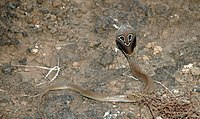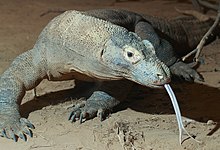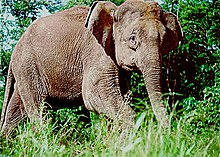Fauna of Asia

All of the animals living in
Origins of Asian wildlife

The formation of the Asian fauna began in the Mesozoic with the splitting of Laurasian supercontinent. Asia blends elements from both ancient supercontinents of Laurasia and Gondwana. Gondwanian elements were introduced from Africa and by India, which detached from Gondwana approximately 90 MYA, carrying its Gondwana-derived flora and fauna northward. Glaciation during the most recent ice age and the immigration of man affected the distribution of Asian fauna (see also Sahara pump theory). Eurasia and North America were many times connected by the
Zoogeographic regions

European-Siberian region
The boreal and temperate European-Siberian region is the Palearctic's largest region, which transitions from
.Mediterranean Basin
The lands bordering the
Middle-East deserts
Western and Central Asia
The
East Asia

Indian subcontinent

The Indian Subcontinent bioregion covers most of
Indochina
The Indochina bioregion includes most of mainland Southeast Asia, including Myanmar, Thailand, Laos, Vietnam, and Cambodia, as well as the subtropical forests of southern China. It covers the richest part of the Indomalayan realm, with dominant biomes of tropical and subtropical moist broadleaf forests and dry broadleaf forests. New species and even families are often found there (e.g. Laotian rock rat). It is home to about 500 native mammal species. The bird fauna is also very diverse, with some 1,300 species. Over 500 reptile and over 300 amphibian species are also present, including numerous endemics. See also the Indo-Burma biodiversity hotspot.
Sunda Shelf and the Philippines
Freshwater
Asia also contains several important
South Asia is especially rich in freshwater life, with 10% of the world's fishes (over 2000 species).

Marine fauna
There are strong affinities and relationships between Mediterranean and Atlantic faunas. The deep-water fauna of the Mediterranean has no distinctive characteristics and is relatively poor. Both are a result of events after the Messinian salinity crisis.[7] An invasion of Indian Ocean species has begun via the Suez Canal (see Lessepsian migration).
The
Reptiles
Asia has a rich



The
Birds

One bird family, the
Mammals

Two orders of mammals, the
Human impact

Across Asia wildlife populations and habitats are being decimated by poorly controlled industrial and agricultural exploitation, by infrastructure development (construction of dams, roads and tourist facilities), and by illegal activities such as poaching and timber theft. The result is
Extinct animals
See also
References
- ^ a b Geptner, V. G., Sludskij, A. A. (1972). Mlekopitajuščie Sovetskogo Soiuza. Vysšaia Škola, Moskva. (In Russian; English translation: Heptner, V.G., Sludskii, A. A., Komarov, A., Komorov, N.; Hoffmann, R. S. (1992). Mammals of the Soviet Union. Vol III: Carnivores (Feloidea). Smithsonian Institution and the National Science Foundation, Washington DC).
- ^ a b Pocock, R. I. (1939). The Fauna of British India, including Ceylon and Burma. Mammalia. – Volume 1. Taylor and Francis Ltd., London. Pp. 199–222.
- ^ C.B.Cox, P.D.Moore, Biogeography: An Ecological and Evolutionary Approach. Wiley-Blackwell, 2005
- ^ Price, T. D., J. Zee, K. Jamdar, and N. Jamdar. 2003. Bird species diversity along the Himalaya: a comparison of Himachal Pradesh with Kashmir J. Bombay Nat. Hist. Soc. 100:394–410
- ^ Helgen, K.M., Groves, C.P. Biodiversity in Sri Lanka and the Western Ghats. Science, vol 308, 8.apr. 2005
- ^ R.J.Whittaker, J.M.Fernández-Palacios, Island Biogeography. Ecology, evolution, and conservation. Oxford University Press, 2007
- ^ C.C.Emig, P.Geistdoerfer, The Mediterranean deep-sea fauna: historical evolution, bathymetric variations and geographical changes, Carnets de Géologie / Notebooks on Geology, 2004
- ^ Fauna & Flora International in the Asia-Pacific region
- ^ N.S. Sodhi et al., Southeast Asian biodiversity: an impending disaster. Trends in Ecology& Evolution, Vol.19, Issue 12, 2004
- ^ Hughes, A. (2017) Understanding the drivers of Southeast Asian biodiversity loss, Ecosphere. 10.1002/ecs2.1624
